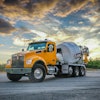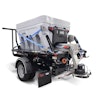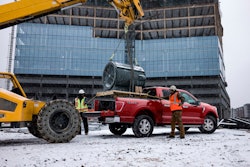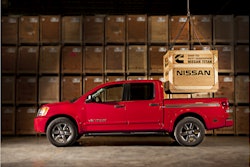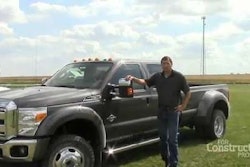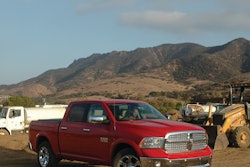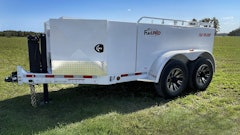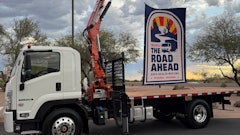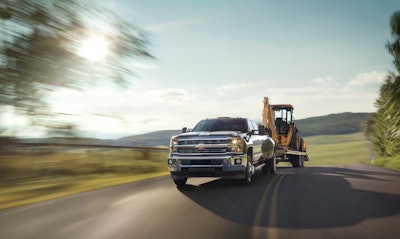
There are many reasons to consider a diesel engine for your next pickup truck purchase. Diesel engines typically deliver 25% to 30% better fuel economy, but you also need to factor in the cost difference between gasoline and diesel. A lot of diesel engines are selected for heavy-duty pickup trucks because of their capability and fuel economy benefits.
Ram Truck recently introduced a diesel option in the 1500 that promises to deliver improved fuel economy, an important feature in the half-ton segment. “It’s interesting to see the shift,” says Mike Cairns, head of Ram Truck engineering. “With fuel economy in the light-duty segment as the driving force of change and new technology available, smaller diesel engines can deliver on both efficiency and capability.”
Brian Rathsburg, Super Duty marketing manager for Ford, cautions that the fuel economy advantage can be hard to quantify due to the many different pickup configurations available. “But if you are in the F-250 portion of the lineup and you have a diesel and are not towing heavy loads or driving at altitude, you can get north of 20 mpg. On a similarly equipped gasoline truck, it could be in the 15- to 17-mpg range. So it is not uncommon for these customers to see 3- to 5-mpg higher fuel economy with a diesel.”
The gap widens further when you’re towing a heavy load. “Diesel engines run more efficiently at high capacities,” says Rathsburg. “On similarly equipped vehicles towing the same amounts, you will get better fuel economy on the diesel engine than you would on the gasoline engine.”
However, the decision of gas or diesel is often based more on capability than fuel economy. That’s why you see a majority of heavy-duty pickups equipped with diesels.
Consider the Ford Super Duty pickups. “About 60% of our mix is diesel engines and the other 40% are gas engines,” notes Rathsburg. “For those 40% who buy a gas truck, they want the utility of a heavy-duty truck, but they may not need the extreme amount of capability that the diesel gives them. As a result, they can’t justify the $8,000 to $9,000 price premium. They may need to haul 3,000 or 4,000 lbs. of equipment in the pickup box and not have a lot of need for towing. Those are the types of usage profiles where we see gas buyers.”
“Ram Heavy Duty trucks have nearly an 80% take rate on the Cummins diesel, where the No. 1 ‘why buy’ is capability,” says Cairns. “Our new 6.4-liter HEMI gas engine closes the capability gap and gives customers who may not require a huge GCWR another option.”
The power characteristics between gas and diesel are quite different. Gasoline engines run at higher rpm and typically produce more horsepower, while diesel engines turn at lower engine speeds and produce more torque.
“When you go from gas to diesel in an HD (heavy-duty pickup), you usually double your torque,” says Tom Wilkinson, Chevrolet Communications. For instance, the Chevrolet Silverado and GMC Sierra 2500 use the Duramax 6.6-liter diesel engine that pumps out 397 hp at 3,000 rpm and 765 lbs.-ft. at 1,600 rpm. This compares to the 6.0-liter Vortec V8 that is rated at 360 hp at 5,400 rpm and 380 lbs.-ft. of torque at 4,200 rpm.
Such results are similar across the product offerings of all heavy-duty pickup brands.
Time to Tow
Towing capacity is a complex topic because there are a lot more variables than simply the engine. There is the axle ratio, GVW, wheel configuration, hitch configuration, etc. This is why manufacturers publish towing tables.
That said, the diesel engine does add towing capability across the range. “If you look at the range of trailering, the lowest trailer rating is 12,500 lbs. for an F-250 gas regular cab. That can go up to a maximum of 16,800 lbs. on a diesel with fifth-wheel capability. That is the full range of F-250 towing from low-end gas to high-end diesel,” says Rathsburg.
How much more you can tow with a diesel-equipped pickup than a gasoline variant has a lot to do with the axle ratio. “The increase in towing from gas to diesel depends on the rear axle ratio,” says Wilkinson. For a basic Chevrolet Silverado 2500 2WD regular cab pickup, the ratings are as follows:
? 6.0-liter gas engine with standard 4.10 axle ratio — 13,500 lbs. conventional, 14,700 lbs. fifth wheel
? 6.0-liter gas engine with optional 3.73 axle ratio — 10,200 lbs. conventional. 10,200 lbs. fifth wheel
? 6.2-liter diesel engine with 3.73 axle ratio (only ratio available) — 13,000 lbs. conventional, 17,800 lbs. fifth wheel
Ratings for a 2WD 3500 crew cab DRW are as follows:
? 6.0-liter gas engine with a 4.10 axle ratio — 13,500 lbs. conventional,
13,500 lbs. fifth wheel
? 6.6-liter diesel engine with 3.73 axle ratio — 16,500 lbs. conventional,
22,800 lbs. fifth wheel
“At the upper end, the diesel makes much more difference,” says Wilkinson.
Ram Truck 2500 specs show increased towing capability with the diesel when equipped with the same axle ratio. However, the increased weight of the diesel results in 830 lbs. less payload capacity, as shown:
? 6.7-liter Cummins diesel 2-door, 2WD with 4.10 gears — 17,970 lbs. towing, 3,140 lbs. payload
? 6.4-liter HEMI gasoline V8 2-door, 2WD with 4.10 gears — 16,300 lbs. towing, 3,970 lbs. payload
For the Ram 3500 diesel, note the dramatic increase in towing capacity:
? 6.7-liter Cummins, 2-door, 2WD, 4.10 gears — 30,010 lbs. towing, 6,570 lbs. payload
? 6.4-liter HEMI V8, 2-door, 2WD, 4.10 gears — 16,450 lbs. towing, 7.320 lbs. payload
“Payload is a function of the GVW of the truck, or the maximum rating of what the truck can hold minus the weight of the truck,” Rathsburg comments. “You can actually haul more with a gas truck than a diesel because the diesel weighs more. That affects your GVW. The payload of a similarly equipped F-250 for a diesel is 3,000 lbs. and that goes up to a maximum of 4,200 lbs. for a gas truck. You really see the capability benefit for a diesel truck in the trailer towing. Because the diesel truck weighs more, the payload is actually higher on a gas truck.”
The weight difference is roughly 700 lbs. for an F-250 diesel over a similarly equipped gasoline model. “That is the weight of the engine, fluids, aftertreatment system, DEF tank and DEF fluid itself,” says Rathsburg. Other manufacturers note similar weight differences.
Return on Investment
The upfront investment in a diesel engine is higher. “The Duramax turbo diesel is $7,195, plus another $1,200 for the Allison transmission,” says Wilkinson.
Other manufacturers note a similar price premium for heavy-duty pickups, ranging from $8,000 to $8,500. The return on this investment needs to be identified up front.
“ROI would vary by customer,” says Wilkinson. “Fleets and other cost-conscious customers seem to lean toward the gas engine because it is so much less expensive to purchase. But customers buying uplevel trucks tend to favor the diesel, especially if they are doing a lot of towing. As with any premium engine, performance may be as much a factor as ROI. If you want or need torque, nothing beats a diesel.”
Rathsburg agrees, adding, “The payback period on a gas vs. diesel is difficult to quantify. But on average, if you are driving 20,000 miles a year and you are getting 3 to 5 mpg better fuel economy with a diesel, that will pay back in three to five years. There are so many variables that it is hard to really specify it. But the general rule of thumb is the more you drive and the higher the fuel economy advantage that you see for the diesel vs. the gas, your payback period is going to get smaller.”
The increased capability of the diesel also plays into this equation. “We can tow almost 25,000 lbs. of weight [with the Super Duty]. With a gas truck, you are less than half of that,” Rathsburg points out.
“There is a wide range of consumer opinion,” says Nick Cappa, Ram Truck. “Not everyone likes to tow close to max capacity. Many enjoy putting the truck in high gear, setting the cruise control and hitting any grade without downshifting. The ROI isn’t always based on initial cost. It also includes comfort. Towing with a bigger diesel provides confidence and comfort with fuel economy. The take rate for our 6.7-liter Cummins engine is around 80%, which says a lot about the importance of capability.”
He adds, “Although this makes a Total Cost of Ownership calculation difficult for personal use, a financial view can be done for business use. There are varying duty cycles and some include a load weight per route calculation, of which a diesel will yield a better result. Fuel economy of a diesel under load is the greatest operational benefit when compared to a gas engine under the same load.”
You also need to factor the resale value into the total cost of ownership. “We generally see about a 10% improvement over a gasoline engine in terms of higher resale value,” says Cappa.
According to Rathsburg, “We would expect the diesel engine to have a higher resale value because it is a more capable vehicle. It is designed to tow and haul more. We would expect to see 5% to 10% higher residuals for a diesel Super Duty vs. a gasoline Super Duty. That is assuming all of the other specs are the same.”
Maintenance on diesel engines also tends to be lower. Fewer oil changes are required and, when equipped with an exhaust brake, brake pad and rotor life is greater. Of course, that doesn’t mean diesel engines are without their unique maintenance requirements. For example, they have water/fuel separators that periodically need to be drained.
The Case for Light-duty Diesels
The performance gap between diesel engines and their gasoline counterparts does narrow as engine size decreases. “In general, the bigger the diesel, the bigger the torque vs. horsepower gap,” says Cappa. “It’s mostly due to how we design and calibrate the engines for their intended purpose.
“New technology allows all diesels to rev higher and compete with gas engines in 0- to 60-mph acceleration, but smaller diesels benefit more from that because of their application in smaller vehicles,” says Cappa. “Higher revs help contribute to higher horsepower numbers and larger trucks don’t benefit the same way as smaller vehicles.”
Ram Truck became the first to roll out a light-duty diesel for the 2014 Ram 1500. The 240 hp and 420 lbs.-ft. of torque will translate into 9,200 lbs. of towing capacity, while delivering better than 25 mpg on the highway. “Combined with the low acquisition price of $2,850 over a HEMI, we will be able to pay back the customer’s investment in less than four years with this engine and it will have a lot of useful life after that,” says Dave Sowers, head of Ram Truck light duty and heavy duty marketing.
“When comparing our new 3.0-liter EcoDiesel in the Ram 1500 to our 5.7-liter HEMI V8, the comparison is much more interesting,” says Cappa. “The smaller diesel has higher torque but lower horsepower. The acceleration is amazing for the size of the diesel engine. The 420 lbs.-ft. of torque and its delivery allow the smaller EcoDiesel to play in the V8 gas arena with increased fuel economy.”
Nissan has also announced it will offer a 5.0-liter Cummins V8 diesel as an option in its Titan. This engine is published to make roughly 300 hp and 500 lbs.-ft. of torque. The current 2013 Nissan Titan is available with a 5.6-liter V8 gasoline engine that pumps out 317 hp and
385 lbs.-ft. of torque.
The all-new Cummins ISV5.0 will be available to other auto makers, as well, and was designed to fit in practically any truck engineered to accommodate a V8 or V10 engine. Several versions will be offered ranging from 200 to 275 hp with a maximum of 560 lbs.-ft. of torque.
“We have done our homework on the next-generation Titan. Truck owners told us there is a demand for the performance and torque of a diesel in a capable truck that doesn’t require the jump up to a heavy-duty commercial pickup,” says Fred Diaz, divisional vice president, Sales & Marketing, Service & Parts, Nissan North America.
Other manufacturers are keeping a close eye on the emerging light-duty diesel market. “The market will tell us if there is room for the diesel in the light-duty segment,” says Rathsburg. “It really becomes a value play... Is the payback period for the premium they would have to pay for that light-duty diesel worth it in terms of the fuel economy? That remains to be seen. We will certainly keep an eye on it. The value will be dictated by the fuel economy, because anybody who really needs the capability is going to step up to a heavy-duty pickup.”

